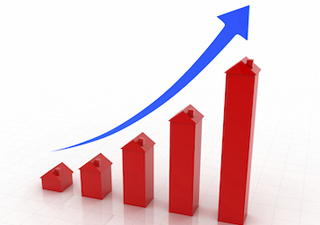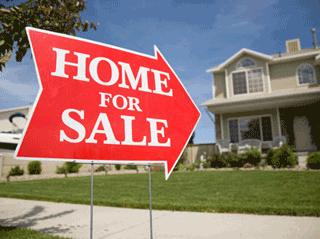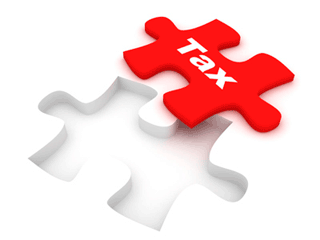Quote of the Week
“Despite the rise in new listings nationwide, absorption rates are picking up pace, so much so that total listings actually fell over the same period. Right now demand is swamping supply. And nowhere is this the case more than in regional Australia.”
SQM Research’s Louis Christopher
Price Rises The Fastest In 17 Years
 Australian property values grew at their fastest rate in 17 years in February, with every capital city and all regional markets lifting their dwelling prices.
Australian property values grew at their fastest rate in 17 years in February, with every capital city and all regional markets lifting their dwelling prices.
The rare circumstance of all 15 market jurisdictions (eight capital cities and seven regional markets) rising strongly at the same time confirms that Australia is experiencing a nationwide real estate boom, the first since 2001-2003.
National home values rose 2.1% in February to a median of $599,000 – the largest month-on-month increase since August 2003.
The two biggest capital cities recorded the strongest monthly growth: Sydney’s median home value rose 2.5% to $896,000 and Melbourne’s rose 2.1% to $718,000. Hobart property values also recorded a 2.5% monthly rise to $536,000.
But, in annual terms, the growth in house prices is being led by Darwin (up 16.3%), Regional Tasmania (14.6%), Regional South Australia (11.6%), Regional NSW (11.5%), Canberra (11%) and Hobart (10.2%).
CoreLogic’s research director Tim Lawless describes the growth in property markets as “phenomenal” against the backdrop of the pandemic.
Listing Levels Still Dropping
 Low levels of listings of properties for sale are helping to push up property sales and in February listings overall fell further, despite an increase in new listings.
Low levels of listings of properties for sale are helping to push up property sales and in February listings overall fell further, despite an increase in new listings.
Figures released this week by SQM Research reveal total listings nationwide fell 2.7% in February to 257,592 from 265,116 in January.
Compared to 12 months ago, listings are down by 13%. The largest monthly decreases were in Adelaide, Brisbane and Perth, but compared to a year earlier, listings fell the most in Hobart and Adelaide.
The overall fall in listings comes despite a 52% rise in new listings in February to 76,430 new properties on the market, to be up 6% over the year. Canberra new listings jumped the most by 94% while Sydney also recorded a robust rise of 71%.
Listings overall are declining because buyers still outnumber sellers and available properties are being snapped up quickly by competing buyers.
Borrowing Binge Hits New High
 Australians committed to $28.8 billion in loans in January — 11% more than in December and 44% more than a year ago. CBA economists described the surge in new lending as “astonishing”.
Australians committed to $28.8 billion in loans in January — 11% more than in December and 44% more than a year ago. CBA economists described the surge in new lending as “astonishing”.
Borrowing by owner-occupiers lifted 11% in the month to $22.1 billion — up 52% from January 2020, seasonally -adjusted figures from the ABS reveal.
“There were rises in all states and territories with the exception of the Northern Territory,” says Adrian Kelly, president of the Real Estate Institute of Australia. “The value of new loan commitments to owner-occupiers rose 11%, the largest monthly increase since August 2020.
“Loans to investors also increased for the eighth consecutive month, with the value of loan commitments for investors rising 9.4% for the month, the largest increase since September 2016, and 23% for the year.”
The number of first-home-buyer loans increased 9.6% for the month and is 71% higher than twelve months earlier. This is the highest FHB level since May 2009.
Clearance Rates Rise In Most Cities
 Home prices across the country are expected to rise further as buyers push clearance rates significantly higher.
Home prices across the country are expected to rise further as buyers push clearance rates significantly higher.
Almost 90% of properties auctioned in Sydney at the weekend sold, compared to 76% this time last year. Clearance rates were also higher in Melbourne, Brisbane, Perth and Canberra. The median price of an auctioned home hit $1.12 million across six capital cities last weekend.
Aussie Home Loans chief executive James Symond says the surge in property interest is being driven by multiple factors, including “consumers who have saved a truck load of money during the pandemic and an unemployment outlook that wasn’t as bad as we thought”.
Other factors include a stronger than expected economy, government stimulus measures, the Exodus to Affordable Lifestyle trend, the return of expat Australians in large numbers, low listing levels and ultra-low vacancy rates in most locations.
“The market is very solid,” says Symond. “It’s a good time for families with good jobs and income to get a mortgage and join in this active market.”
Labor Axes Property Tax Policies
 Labor has dumped changes to negative gearing and capital gains tax from the final draft of its 2021 party platform, as Anthony Albanese moves to scrap more of Bill Shorten’s economic policies ahead of the next election.
Labor has dumped changes to negative gearing and capital gains tax from the final draft of its 2021 party platform, as Anthony Albanese moves to scrap more of Bill Shorten’s economic policies ahead of the next election.
The Australian reports that, while the shadow cabinet has not yet determined its tax agenda for the Federal Election (which could be as early as this year), the draft party platform released this week excludes mentions of changes to negative gearing and capital gains tax. Franking credit reforms have already been dumped.
The draft Labor plan for the nation will be debated and ultimately set by the party’s national conference starting on March 30. Labor’s Treasury spokesman, Jim Chalmers, told The Australian that tax policies Labor took to the 2019 election would not be retained.
Business groups and Labor MPs have tentatively welcomed the Opposition Leader’s vision for the party, with the Property Council of Australia and Master Builders Australia warning that new taxes would hamper the nation’s post-pandemic economic recovery.




